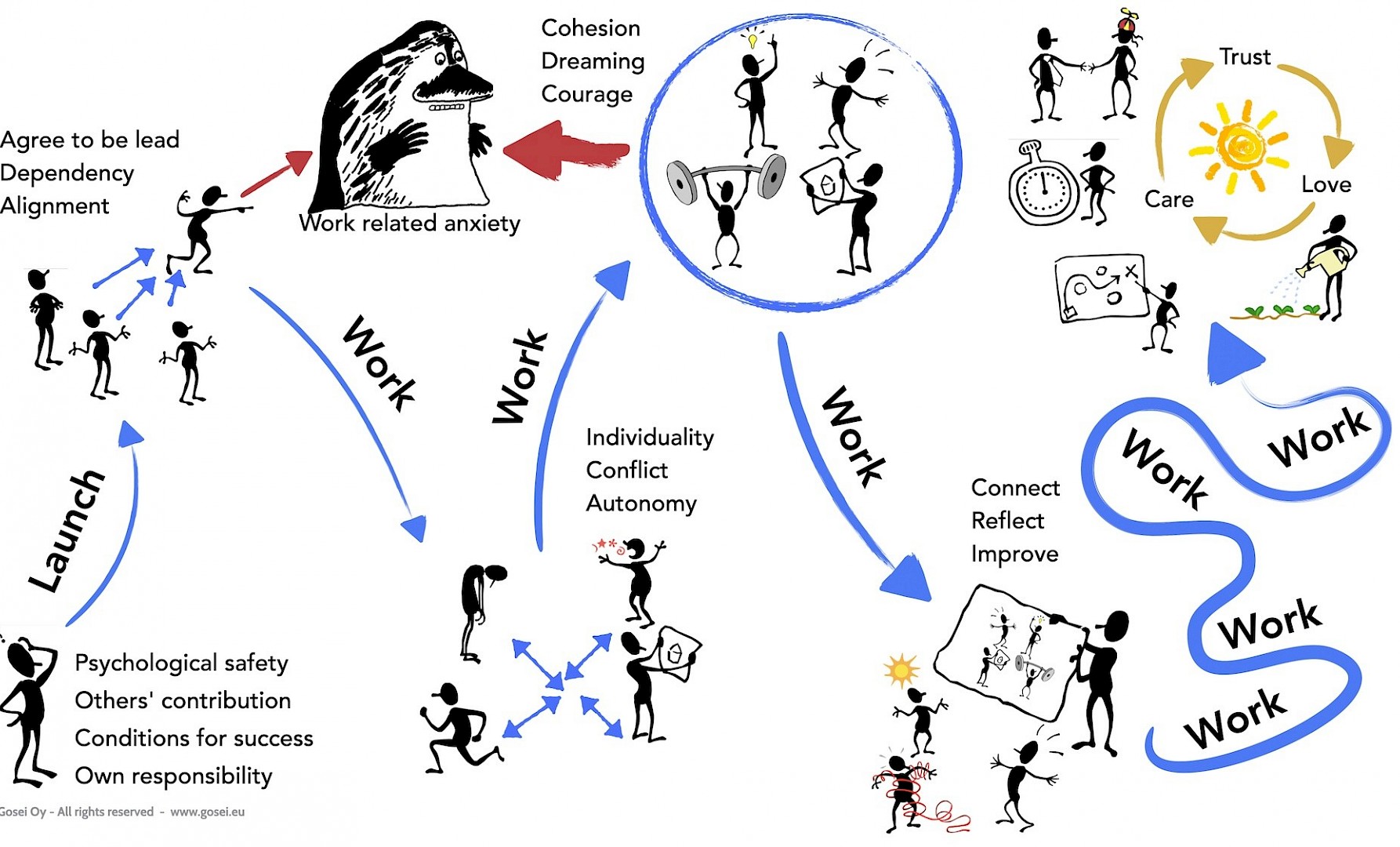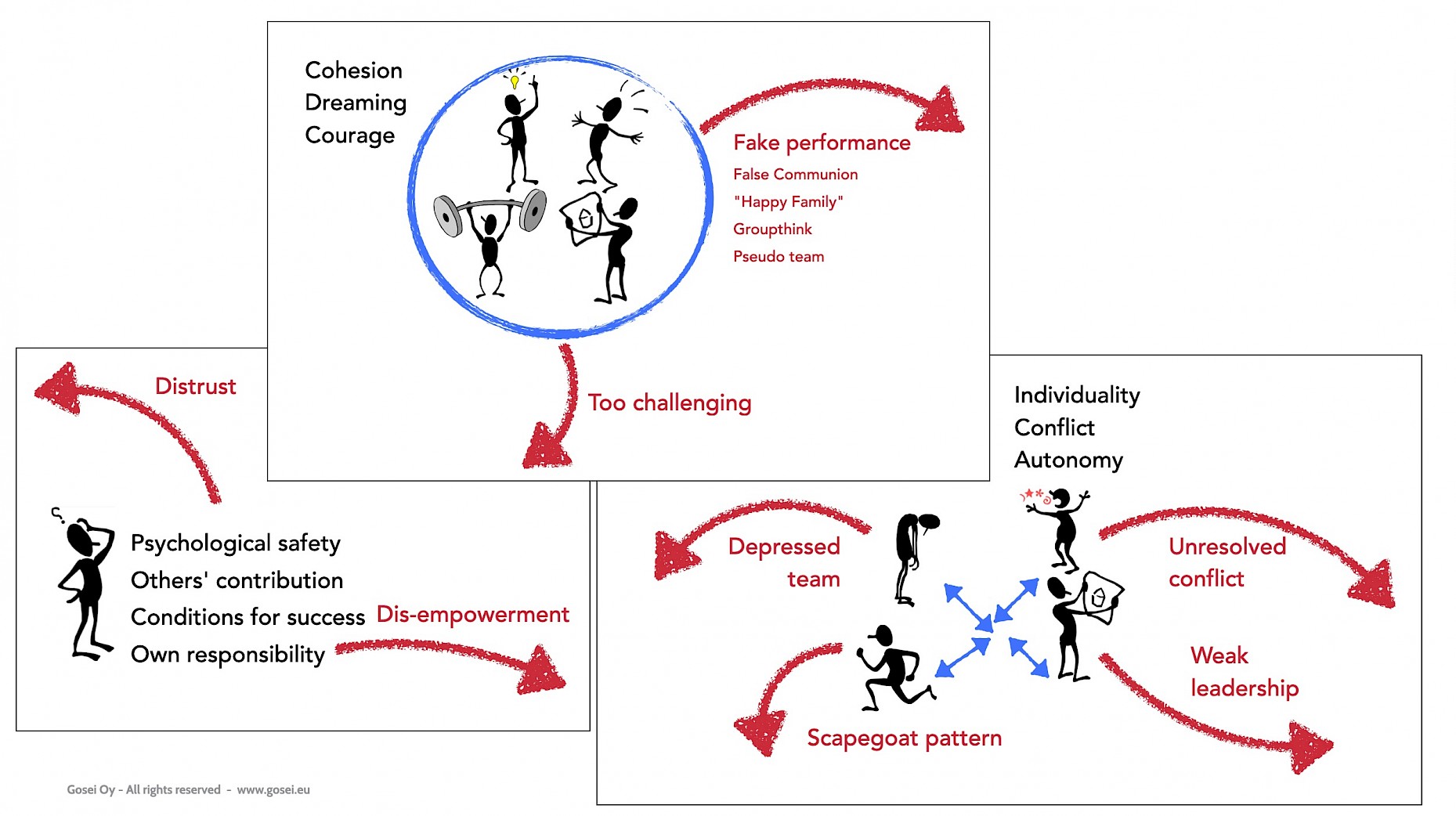Trust, Care, and Love
7.6.2024 — Build the culture of Trust, Care, and Love for the shared mental and physical space.

Five significant patterns that are essential for group dynamics in teams. They happen all the time and have an essential function in the beginning. Skillfully facilitating them, again and again, will gradually develop a culture of Trust, Care, and Love for the shared mental and physical space.
Our instinctive traits for working in smallish, co-located teams have evolved over thousands of years. The same human needs, behavior, and potential exist in remote teams and larger organizations but are invisible. Understanding them is essential for good leadership.
However, even co-located teams struggle in the workplace. The researchers Richard Hackman and Susan Wheelan, as well as popular writers Katzenbach and Patrick Lencioni, who actually studied teams, all open their books by stating that good Teamwork is rare.
Trust, Care, and Love
Ikujiro Nonaka (1935-), the famous researcher of knowledge-creating organizations, researched and preached these bold words around 2000. Nonaka's approach was to study real organizations and observe for successful patterns. For example, in 1984, after studying a handful of special projects, he coined the word Scrum in the sense we nowadays use it for the Scrum process.
Nonaka's special interest was tacit knowledge, the unconscious or implicit knowledge. Formal concepts, language, and documents can convey explicit knowledge, but it is only the tip of the iceberg. Tacit knowledge is the invisible basis.
Tacit knowledge is only learned by imitation, by working together - by doing Teamwork. Trust, Care, and Love enable us to work with tacit knowledge.
Another researcher, William G. Ouchi, studied control mechanisms in organizations. He approaches from the opposite direction, stating that Teamwork is the only way to tackle novel, ambiguous, and interdependent challenges, where working with tacit knowledge is the key.
1 Individual's perspective
Individuals want to become respected members of a team that succeeds. It will then provide them with safety, connection, and livelihood. People instinctively have three questions in mind:
- Am I treated fairly? Especially, will I be punished for disagreeing? This psychological safety has been a hot topic lately, but there is more...
- Will others do their part? Are people competent and willing? Social loafing is a real question in any social system.
- Are we going to survive? Do we have the conditions for success?
This is old knowledge, re-confirmed by Google's large ReWork research in 2015. Google wanted to know who are the team players, but found that team culture is more significant than individual traits. The five factors from Google's research fit well the points above.
Then we have the personal factor. Teamwork skills and experience matter, especially when the team needs to learn fast.
When joining a team, some facts are known beforehand, but mostly superficially. There are always surprises when you meet new personalities in a new team. Everyone is going through their favorite change resistance curve, which can pass quickly or take longer, depending on the situation and person.
People can take ownership of the situation and choose learning, open communication, and conscious choices. This can be supported through good launch facilitation, and it can be a personal intention. The opposite would be a victim attitude and extensive defensive behavior.
2 Launch
Preparations
Launch is the moment of truth. It is the first time all relevant people and ingredients are in the same room. It is the first time trying to work together, which is what Teamwork is about. Within minutes, the people form their first impression of whether we will succeed or not.
Richard Hackman stated in his landmark books that 60 % of the success is made in the pre-work (creating the conditions), 30 % in the launch, and 10 % while coaching the ongoing work.
Hackman did research on Teamwork for 40 years at Harvard. He crystallized his findings in 6 conditions (2011):
- Right People
- Real Team
- Compelling direction/Purpose
- Supporting Organizational Context
- Clear norms of conduct
- Team-focused Coaching
This is the single most important advice for creating successful teams. Please start with this article, and read the books!
Organizations have three natural stakeholders: Customers, Workers, and Owners. The team's profit-and-loss-responsible Sponsor represents the Owners, who have put their wallets on the table to create a well-working organization.
So the Sponsor sees that the conditions and launch facilitation are flawlessly prepared. She of course is using other people as well as her own time and effort. Unlike "Just figure it out, you are adult people."
Dependent Group Dynamics
When people enter the room, they start to look for collaboration. First, they need to make eye contact with each other. Next, they need to become visible in the group with their chosen history, first in pairs and then with the larger group.
Now, the team to come is in confusion. There is some understanding but also a lot of unanswered questions and needs. People start to probe who would lead us away from this confusion and anxiety. Different people offer their leadership, and finally, someone in the room is accepted as the situational leader.
The team has formed for the first time. Everyone has agreed to be lead by the chosen leader. It is sometimes amusing to see how team members exaggerate the wisdom and power of the leader by asking trivial questions, just to express their subordination.
The team may struggle to find this pattern when there are strong personalities, such as experienced specialists who want to do things their way. Or if there is no-one who dares to take leadership. This can be helped by creating clarity about the structures and goal, a clear assignment by the sponsor, and skillful facilitation. Good teamwork skills make this a breeze.
Like a newborn baby, the group is still vulnerable and protected by the chosen leader's strength. In this way, the leader helps the group face the work-related anxiety.
Now, the leader needs to clarify the confusion and/or make the group succeed in some work.
Facilitation
A good facilitation covers all previously mentioned challenges:
- Meticulous pre-work
- Inviting invitation
- Check-in that supports the members to join the team
- Credible welcoming speech by the Sponsor, presenting the conditions of success
- The Sponsor setting the expectations for the team: to put effort in and collaborate
- Exercises for the team to clarify the situation, like knowing each other, clarifying the goal, agreeing on the first norms, and mapping the context.
- Start to work
A specialized coach/facilitator may be beneficial, depending on the challenge and experience of the people involved. Whoever is leading the launch needs to adjust the dependency: In confusion, offer to lead, and with flow, give responsibility to the group.
The launch event is a unique opportunity to train Teamwork skills:
- The right people are present - no need for the time and effort for a separate training
- Learning about the real thing going on right now is motivating and enlightening
- The team norms have not yet been established and are easier to shape
- Real learning at the individual level and at the team level when people witness each other's actions and reactions
- Effective and economical to add small theory inserts and explain the why and how of the launch facilitation
Whenever the team falls into confusion, a mini-launch will get them back on track. Knowing how to launch is the basis for stable, productive teamwork.
Invite us to make your launch a business success and a great learning experience.
Work
Learn to share workload, competence, and leadership. This is the key to teamWORK. Do this from the very beginning, even when it seems uncomfortable first.
The team will try out working. For different work-related questions, the team will listen to different situational leaders. The team as a whole is still new and vulnerable. Team members give up their personal wisdom to align with the team and tend to use easy-to-agree solutions.
Learning about the realities and success in work increases the trust related to the individuals' three major questions.
3 Individuality emerging
As increasing trust strengthens the team a little, individual members dare to challenge the leadership. They challenge the alignment and demand autonomy to work at their full capacity.
People seek support from small groups, which will have disagreements (aka conflicts) with other subgroups. Some conflicts are about practical work, and some also have the flavor of group dynamics.
Whoever takes the role of the situational leader needs to solve these conflicts so that the solution supports individuality, autonomy, and psychological safety.
To protect the still vulnerable team, the leader needs to pull all the critique towards herself. This makes her a strong and safe leader and prevents the conflict between the subgroups from threatening the team's integrity.
Work
The team continues to work. There is more freedom to align for decision-making and planning and to work separately for effectiveness.
Learning and success in work increase trust. The team will find a practical balance between alignment and individuality. The members start to form an emotional bond with the team, which now fulfills their needs for connection, safety, autonomy, and sustenance.
4 Courage from Cohesion
Only after balancing alignment and individuality is the team able to work as one. Earlier, brave or rebellious individuals brought up difficult questions, but the team as one has not responded. Now, the team - as one team - starts to see the external challenges and gathers courage from group cohesion. It dreams about success, even unrealistically, and gradually turns into planning.
The blessing of this pattern is overcoming work-related anxiety, removing friction and hesitation, and finding unwavering commitment. It raises the feeling of safety to a new level and enables the members to work in a flow state.
Work
The work is now more effective, resulting from learning and smooth collaboration.
The group dynamic patterns explained above emerge as responses to acute situations, passing briefly or going deep for serious questions.
Whenever the team needs to work aligned, such as when making decisions, planning, or clarifying confusion, it will use the dependent pattern. Different people offer their solutions, and the team finally converges on one.
With any kind of disagreement in thinking or doing, the pattern called flight-fight will emerge. Some people will fight, and some will escape mentally or physically. The team now needs a leader and a moment of dependency to clear the confusion and return to work.
The team will use group cohesion to face challenges or just to enjoy a moment of rest.
5 Retrospectives
In a Retrospective team or the larger organization takes time to think about how we are doing. There is plenty of advice for retro facilitation, so I will only point out their precious value to the group dynamics.
When the team tries out Retrospectives early on, they will improve the development of group dynamics on two levels. The main focus is improving success in practical, real work. Simultaneously, the team comes together and practices the essential patterns explained above. The development of group dynamics happens on a small scale also during the Retro meeting
In the beginning, the team will take up easy questions and commitments. It will defend itself from too difficult questions, even if some individuals want to discuss them.
Later, with increased trust and cohesion, the team as a whole will look in the mirror and ask how we are doing, where we failed, where we succeeded, and where we - as a team - commit to doing differently.
The established Retro structures provide safety to bring up difficult questions. Good facilitation provides a safe fall-back to dependency and strong situational leadership to help with fight-flight. A well-facilitated Retrospective improves team cohesion by:
- Connecting people. Everyone is invited to the same room to participate and influence
- Safety. The structures focus on the substance, not people. Different views are invited and not punished; for example, participating leaders are not pressured to give answers.
- Courage is gathered by accepting realities, looking at success, and dreaming together about solutions.
Please check our page about establishing Retrospectives and Continuous Improvement.
Work
It is essential to work, have regular Retrospectives, and create an effective improvement mechanism. If the system does not improve, Retrospectives become frustrating. Sadly, when this happens, teams and Sponsors often give up Retros and stop the improvement.
A little about dysfunctions
The measure for Teamwork is performance, getting the right things done.
Perceived team underperformance may be just unrealistic expectations. Low performance may be process-oriented, like lacking skills, bad tools, or incoming bad quality. Or it might be something about collaboration. Interestingly, too low expectations may actually invite dysfunctional group dynamics.
If you consider acting, think first. Observe carefully and gather undeniable evidence. Consider multiple perspectives and hypotheses. Plan a participative, gentle, and firm intervention. Prepare to provide excessive leadership and coaching support. In most cases, the structures need to improve, and Hackman's conditions for Teamwork provide a good checklist.
Dysfunctions become visible in the five patterns. Failures may be obvious, like unresolved conflict, or more intricate, like the scapegoat pattern. Fake performance is significant and popular, as shown by the many theories developed by different authors.
Please drop us an email if you suffer from a strange dysfunction. We gladly offer first aid advice, just out of the curiosity to hear about real cases.

Resources
J. Richard Hackman: From causes to conditions in group research (article)
J. Richard Hackman: Collaborative Intelligence: Using Teams to Solve Hard Problems
Susan A. Wheelan: Creating Effective Teams: A Guide for Members and Leaders
Maria-Elisa Männistö:Collective sensemaking during the early phases of sustainability working group identity creation: Walking the sustainability talk (Doctor's dissertation)
https://retrospectivewiki.org/
Esther Derby, Diana Larsen: Agile Retrospectives: Making Good Teams Great

